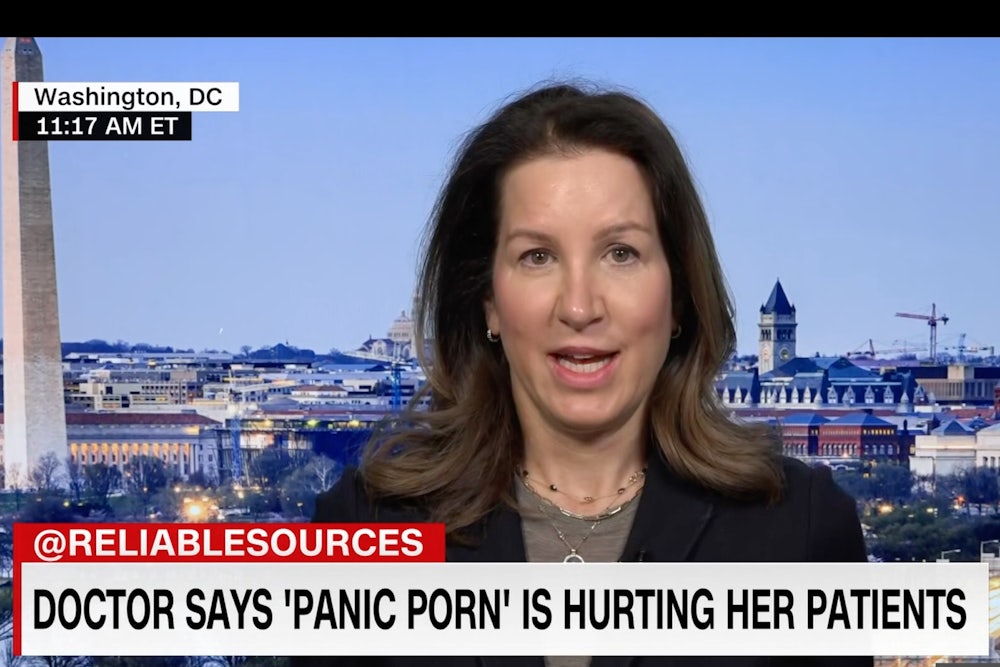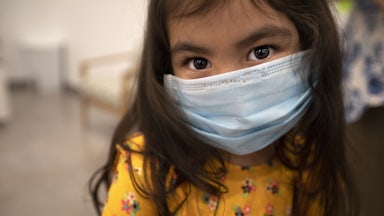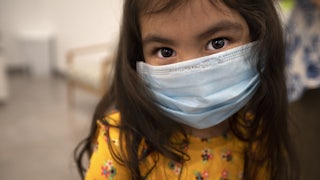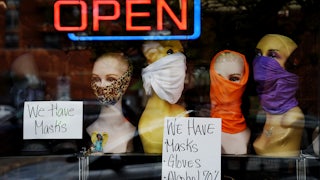Since the pandemic began, everyone has longed to get back to normal. For parents, in particular, who faced long waits to get children over 5 vaccinated and whose hopes were recently crushed by the announcement that the under-5 vaccine would be delayed, there has been little reprieve. We worry about everything: How safe are their playdates and school days? Do face masks affect their development? Will they be the unlucky ones, the sobering footnotes in every story, who face severe illness or death?
Every parent wants the same thing: a healthy, stable future for our kids. We want to put the stress and pain of the pandemic behind us.
But the past few weeks have shown that there is stark disagreement on the best path to a new normal. While the pandemic still rages, with 25 percent of children 5 to 11 and a little more than half of 12- to 17-year-olds vaccinated, a vocal minority of physicians and scientists has called for the end of precautions. Some of them, organized in a movement they call “the Urgency of Normal,” are finding an eager audience in those who have largely been spared the worst of the pandemic. The group says the precautions, more than the pandemic itself, are causing mental strain and potential harms to children. If the precautions are lifted, kids can return to normal.
Public health experts, meanwhile, point to what they say is a huge flaw in this reasoning: Removing precautions before meeting various vaccination, treatment, and caseload benchmarks could let the virus spread unchecked, develop more dangerous variants, and put “normal” out of reach for much, much longer.
There is, to be clear, little scientific disagreement about what helps quell the pandemic. Vaccinations, masks, ventilation, tests, staying home while sick—these layers of protection, when employed, are highly effective at keeping the virus from spreading, which is especially urgent with 109,000 daily cases, 2,000 daily deaths, and many hospitals still at capacity.
The science is strong. But this movement to drop pandemic precautions is about something else entirely—a potent mix of pandemic fatigue, politics, individualistic thinking, and, if both polling and pandemic statistics are to be believed, a persistent divide based on class and race.
Right now, that debate centers around masks, although in the future it will likely shift to quarantine, isolation, testing, and vaccine mandates. In the past two weeks, governors have begun rolling back the few state-level mask mandates that existed. Some are setting dates for lifting school mask requirements, as well. Only 13 states had school mask mandates in place at the start of the month, and nine recently announced they would soon end. In the absence of state-level policy, requiring masks is a decision made by individual school districts. Most experts agree it should be based on local conditions—rates of cases, hospitalizations, and deaths, as well as vaccination rates, demographics, and other factors in each community.
But the Urgency of Normal group wants to go a step further: ending all precautions for children, permanently.
The Urgency of Normal published its “tool kit”—a slide deck about how Covid-19 should be handled—on January 24, with a goal of having all school precautions lifted by February 15. The initial “team” included 13 physicians and scientists who, their website stated, are solely volunteers, with no outside funding. The group called for the complete relaxation of Covid precautions for kids because, they asserted, the pandemic was dramatically affecting child suicide rates, and most kids who get Covid are fine; they also inaccurately compared Covid-19 to the flu.
One of the founders and a vocal proponent for change is Dr. Lucy McBride, an internist in Washington, D.C., who works as a concierge physician—usually a doctor with limited clientele who does not accept insurance. In addition to ending mask mandates in schools, she told me, she wants required quarantines to end, as well as testing for asymptomatic children. “The problem right now is we’re isolating and quarantining healthy kids,” she said, arguing that the decision to quarantine a child who is exposed to the virus should be up to parents and pediatricians. (Public health experts have told me this policy would likely lead to further spread, since people are highly infectious before they ever show symptoms. This could be particularly problematic if masks are not required in classrooms.)
Other members of the group include Dr. Scott Balsitis, a virologist who develops antivirals and monoclonal antibodies for Gilead Sciences, which makes the Covid antiviral remdesivir (Balsitis did not return interview requests by press time), and Dr. Vinay Prasad, a hematologist and oncologist who joined the group shortly after it was formed. Prasad also writes for the Brownstone Institute for Social and Economic Research, a group advocating a more libertarian approach to the pandemic. (After this article was published, Prasad clarified on Twitter that the pieces on Brownstone’s website are republished from his Substack newsletter.)* Brownstone’s donor breakdown is unclear, but its founder consults for the American Institute for Economic Research, which receives funding from the Charles Koch Foundation and a Koch-funded public relations firm Emergent Order. AIER aided the Great Barrington Declaration—an early (and widely denounced) campaign to drop Covid precautions under the theory that “focused protection”—i.e., precautions only for the vulnerable—would be sufficient. Brownstone describes itself as”the spiritual child of the Great Barrington Declaration.” (One Koch-backed group has also been linked to school unmasking efforts.)**
These individuals are part of the growing throng of voices calling for a return to normal immediately. For if the past few weeks of newsletters, op-eds, and magazine pieces lamenting lingering precautions have made anything clear, it’s that the days of “listen to the epidemiologists” are over. The chorus of high-profile demands for an immediate cessation of Covid-19 precautions, at least in certain corners of the nation, is growing louder—even as the public popularity of such measures holds steady.
Tyler Black, a child and adolescent psychiatrist and suicidologist at BC Children’s Hospital in Vancouver, hadn’t heard anything about the Urgency of Normal group or its “tool kit” until it came out. But when he saw it go up on Twitter, he was appalled. “Their document was so poor, with so many mistakes, that it required immediate public correction,” he said. He messaged some of the signers directly on Twitter, he said, and when no one responded, he went public, in a detailed Twitter thread that focused on his area of expertise: child mental health. Several other subject-area experts did the same, debunking comparisons to the flu and diving into the dismissal that many kids are fine. The central problem he saw was that the group claimed that masks harm children’s mental health and social development—something he’s seen no evidence for in his own work.
“It was really, really gross to see what they did with the mental health science. It’s a true perversion of what science communication is supposed to be,” Black said. “They had mis-cited the CDC—I’m not talking about they made a mistake, I’m talking about mis-citing. Academic misconduct.” The Centers for Disease Control and Prevention study found that there was no significant increase in child suicide, yet the group used that study to claim the opposite—an increase in suicide. After pushback, the authors edited the tool kit to remove that mention of suicide, he said, without noting what had been revised.
Early data in the pandemic did show increased signs of distress among children, Black said. “Of course, you would expect those to be increasing during a distressing time. If we deployed the same surveys during a funeral, we would conclude that funerals cause harm to kids,” he said.
Longer-term data largely found no significant rise in child mental health disorders in the United States. (The exception is eating disorders, which seem to be on the rise—but there’s little evidence of what exactly is driving the rise; early data indicate no link with remote or in-person school, for instance.) Suicides among kids in the U.S. did not increase during the first year of the pandemic—in fact, during early months, they decreased. There was a spike in suicide attempts in January 2021, when some schools resumed in-person or hybrid learning. But the return to school is often a stressful time for kids, Black said: “It’s this noticeable pattern for anyone who works in child mental health that we are busiest during school time.”
The bottom line about kids’ mental health in the pandemic, Black said, is that “when we ask kids, just as many say that they’re doing better as say that they’re doing worse, and most kids say that their mental health has not changed during the pandemic.” Black is concerned that the authors of the Urgency of Normal tool kit may be miscommunicating the evidence on other topics as well. “They’re picking the science that makes their point, and that by the very definition is extremely biased, unreliable science.”
The scientific errors of the group are a major cause for concern on their own. But they point to a larger movement arising: a distrust of science, even among those who claim to follow it.
“There’s no clear evidence that mandating masks on kids in schools makes any difference,” McBride said. Those who oppose mask mandates frequently say this—that there’s no research showing masks decrease Covid in schools—although a careful review of the evidence shows that they are cherry-picking the data, discarding studies that show masking works. Those who want to end mask mandates say these studies aren’t rigorous enough—they don’t control for vaccination status or ventilation or other confounders, or they focus on adults instead of children.
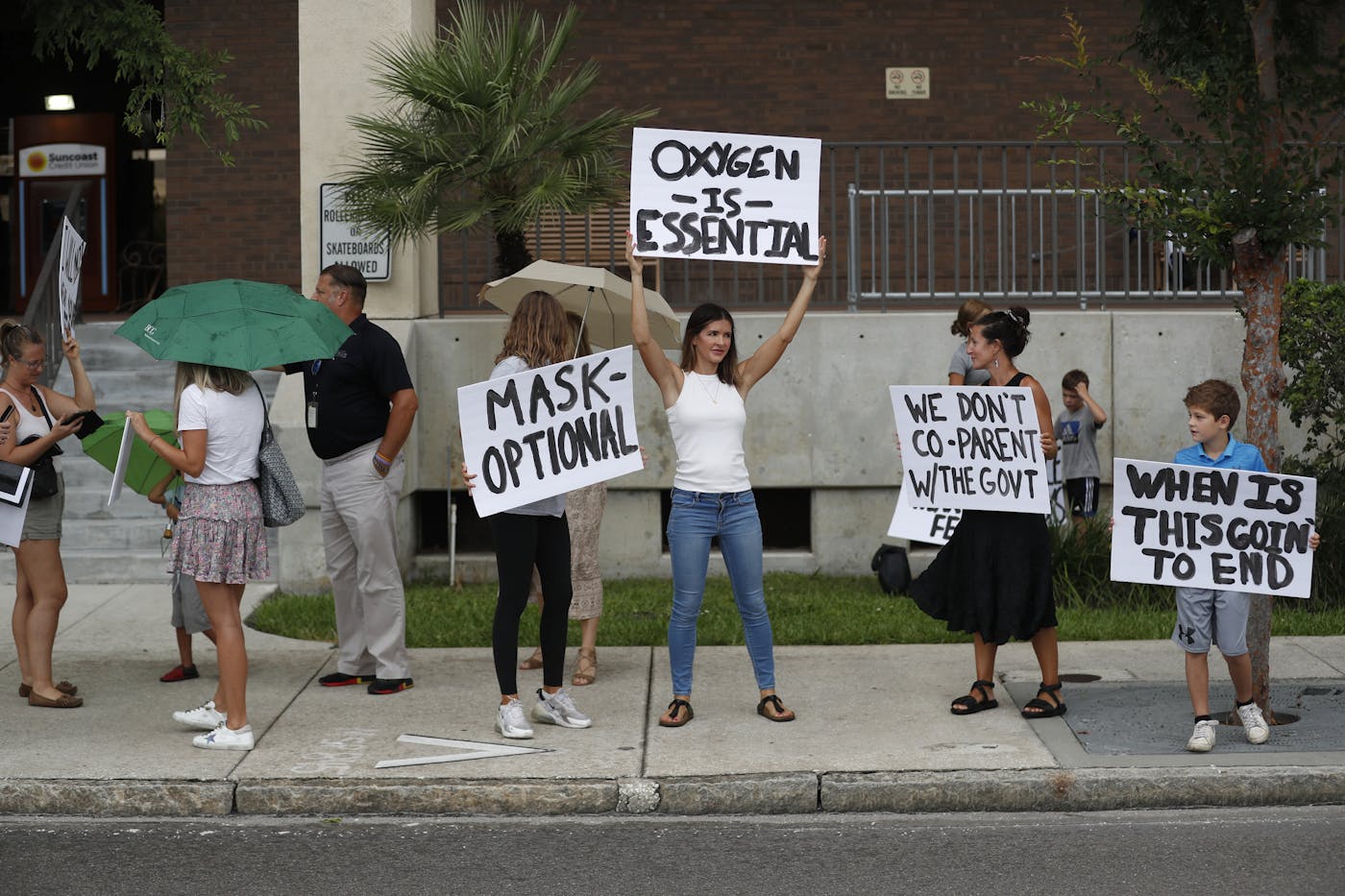
It’s true that the research about masks in schools and day cares is limited—but the data that exist show benefits. The reason such studies lack control groups or focus on adults largely has to do with ethics: Given the strong scientific evidence showing that masks work, it is very unlikely that an ethics review committee would approve a study that has an unmasked control group—particularly during a surge in cases. It is difficult, in real-world settings during health emergencies, to conduct the perfect study on masks, both for these ethical reasons and also due to the sheer number of variables. In one CDC study, for example, schools with mask mandates saw a 21 percent drop in cases compared to schools with optional masking—but the authors cautioned that this finding was not statistically significant, in part because it was difficult to measure how frequently the kids in the mask-optional schools used masks.
When looking at studies like these, experts have repeatedly told me, you look to the totality of evidence—you bring together all of the evidence that exists, and you look for trends. The trend of studies on masks is that they work, in a variety of settings, with no reason to think schools would be any different. Their use in schools is particularly important because schools bring together largely unvaccinated populations in close quarters for long periods of time. The same is true of other measures the Urgency of Normal would abolish, like quarantines and testing after exposure.
Given that the research on masking is pretty favorable to mandates, especially during times of high transmission, the downsides of masking increasingly look political. But even when it comes to politics, anti-maskers run into data problems: Polls show overwhelming support for mask mandates.
In a poll from August, 70 percent of respondents said they supported mandates in schools. In September, before the omicron wave, a different poll found 66 percent of Americans supported school mask mandates. This support is particularly strong when case numbers are high: A poll just last month, in January, found 68 percent of respondents support mandates during a surge, while another from December found only 28 percent of families wanted in-person school without masks during a Covid wave.***
Why, then, are groups like the Urgency of Normal getting so much press? Why are so many stories in the nation’s elite media publications echoing the call for precautions to end?
One answer might lie in whom, specifically, these groups and these pieces are reaching: The places that could actually attain a sense of normalcy are overwhelmingly high-income, white communities that have long been insulated from the worst effects of the pandemic. And these are the locations with the most support for lifting precautions.
“What is striking to me is that they’ve actually not incurred the costs of the pandemic” to a large degree, Lakshmi Ganapathi, a pediatric infectious diseases physician at Harvard Medical School, told me. The rhetoric around the demand for normalcy among those from high-income communities, she added, “suggests that they are the ones who are suffering—when, with objective data, we can see that other communities have suffered even more.”
In one poll conducted in January, 65 percent of parents with household income of less than $75,000 a year said they were either “very worried” or “somewhat worried” about their kid getting seriously sick from Covid-19, and 45 percent said they were “very worried.” Wealthier parents were far less concerned, with only 10 percent saying they were “very worried.” In the same survey, 49 percent of Black or Hispanic parents said they were very worried, as compared to 12 percent of white parents.
This isn’t the first poll to point to divides by class and race. In an August poll, 75 percent of Black parents wanted all kids to wear masks in schools, compared to 54 percent of white parents. Families of color have also been more concerned about the risks of in-person learning, according to some research.
“That’s precisely because these are the communities that have been disproportionately impacted,” Ganapathi said, with higher infection rates, higher mortality rates, more in-person work with less sick leave. “This is fundamentally a pandemic of inequity,” she said. “African American, Latino, and Indigenous children have significantly higher rates of hospitalizations and death.”
Ganapathi’s son attends public school in Boston, in a school where more than 80 percent of the student population is kids of color and kids who receive free lunch. Her principal calls up every family to talk about Covid precautions and ask if they are “too onerous,” Ganapathi said, but “we’ve really not had any parents say that.” They held a fundraiser to improve ventilation, and they required students to wear cloth masks to reduce the amount of virus in the air. As a result, as omicron swept the country, “we only had two para-teachers fall sick during the peak, and we kept our school open,” Ganapathi said.
Many schools, especially with fewer resources, have only recently gained access to the tools that better-resourced schools had for the entire pandemic. “School surveillance testing is a perfect example,” Ganapathi said. “We only got access to testing last year, with a new school year. What they’re saying is that ‘we had access to all of these tools, we are going to do fine, and we’re going to abandon this now—but you, who barely just got access to all of this, should also abandon this.’ And I don’t think they get to dictate that.”
The Urgency of Normal acknowledges that its recommendations are “particularly focused toward highly vaccinated communities.” But what neither this group nor other voices urging normalcy typically emphasize is that there are huge equity problems when it comes to which communities have been vaccinated.
Arguments for returning to normal—and, subsequently, letting the virus rip—hinge on the assumption that those who aren’t vaccinated have made informed, ideological decisions not to vaccinate. (In other words, the vaccinated can ethically expose them to the consequences of their actions by returning to normal life.) That assumption is not accurate. “When they say highly vaccinated communities, what they really mean—and this is backed by data—is highly vaccinated white communities,” Ganapathi said. “They are actually talking about highly privileged, very select communities.”
Communities of color and other disadvantaged communities face barriers to access: logistical and economic challenges, like finding someone to stay home with a child experiencing vaccine side effects when the household needs that day’s income. And vaccine hesitancy these communities experience is frequently linked to highly targeted misinformation campaigns and decades of mistreatment and neglect in the medical system. “I bring up Tuskegee, because that’s specifically what our parents tell us,” Ganapathi said, referring to the distrust some people of color still feel toward the medical establishment. This trust gap can be overcome, but it takes time. “We still need time to get to equitable vaccination rates,” she said, before other precautions are lifted.
When I asked McBride about whether vaccination inequity might complicate her call to end mask mandates and other precautions, she had a different take. The fact that the pandemic’s toll has been inequitable, she said, is why we shouldn’t wait to lift restrictions. Areas with low vaccination rates have already had a large percentage of people get Covid-19, she argued. “The kids who have not been vaccinated are the kids who have been exposed, and a lot of them have antibodies from exposure,” she said. “So the kids who are in, like, inner-city schools in Chicago, where it’s like 20 to 30 percent vaccination rates, those are also the kids who have lost loved ones to Covid-19, and they have been exposed and have some antibodies, which is some level of protection.”
That McBride brought this up is interesting, because the prospect of children losing more loved ones to Covid-19 is also why some experts argue schools should maintain precautions during times of high transmission: While studies suggest masks don’t affect mental health, they say, the trauma of picking up Covid at school and passing it to a grandparent who gets sick or dies can be significant.
The anti-mask crowd doesn’t find this argument convincing. “I see hundreds and hundreds of kids in a clinic space over the course of a week,” one physician in favor of removing precautions like masks and quarantines after exposure, who asked not to be identified because of professional repercussions, told me. “I have not had one child say, ‘What is causing me to be upset is because I had a grandmother die.’”
Yet data suggest that precisely this scenario is playing out, all over the country: 232,000 American children have lost a parent or caregiver to Covid-19, while others have had to care for family members with long Covid. Children are being affected by unchecked Covid-19—just not, it would seem, the children these doctors are treating.
Soon after the Urgency of Normal tool kit was unveiled, some of the group members removed their names but continue working with the group. Others have left over differences in opinion.
One such member is Dr. Monica Gandhi, who has apologized for sometimes getting the pandemic wrong. Unlike other members of the group, she believes lifting precautions should be tied to data. “We need to release mask mandates as time goes on—that they should be linked to metrics,” she told me. That way, she said, it’s easier to implement mandates again if needed. “Then you have the ability to go back. And part of the ability to go back is having clear metrics to begin with.” Clear guidelines could also help the public regain trust in public officials, she said, by being transparent about what the goals are. “We’re really polarized, and we’re a mess, and these kinds of road maps—I think if we’d put this out to begin with, it would have been really useful,” Gandhi said.
The mask conversation has never been truly binary—masks have never been 100 percent protective or completely useless, and the question isn’t whether to wear them forever or abandon them completely. They reduce risk, and as such can be crucial during surges and in crowded indoor settings with low vaccination rates. And that’s another critical distinction in this debate, helping to illuminate where different experts disagree: While doctors may look at individual benefit, public health looks at collective benefit. Any reduction, even if it is imperfect, helps.
Over the past two years, medical experts have learned an astonishing amount about what works to keep people safe and healthy. We learned that Covid spreads through the air, and so do other common respiratory illnesses—reversing decades of medical wisdom.
And that raises the question: Should going “back to normal” really be the goal? The normal the U.S. had before this virus—a fractured health system, gaping social safety nets, and an infamous reputation for focusing on individualism over the common good—is what led us to the highest death toll in the world. Those spared the worst of our peculiarly American failures now want to cover up these cracks and pretend they don’t exist. Yet the very ability to wish for it is a privilege.
* This piece has been updated.
** This piece originally misstated that Emergent Order had been involved in the Great Barrington Declaration.
*** This piece originally misstated the month in which the Axios-Ipsos poll was conducted.
